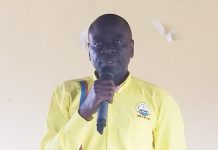Africa-Press – Uganda. Stakeholders in the digital ecosystem are calling for a reduction in taxes on entry-level smartphones and a shift in broadband rollout priorities to drive internet adoption, despite the country’s remarkable progress in expanding network coverage.
This push was made at the inaugural Digital Africa Summit in Kampala, where industry leaders and regulators emphasized the urgent need to bridge the widening usage gap.
At the event, GSMA Africa launched a landmark report urging the government to prioritise affordability and digital literacy over further geographical network expansion arguing that 96% of Ugandans already live within 3G/4G coverage, yet 74% have never gone online.
GSMA Africa Head Angela Wamola praised Uganda’s progress in expanding 4G coverage, which has grown from 50% to 96% of the population in a decade.
But she cautioned that connectivity means little without usage.
“We see that Uganda has made remarkable progress, however, a more important and significant gap arises the usage gap,” Wamola said.
“We have 96% of the population with access to broadband, but 74% have never gone online. That is a big lost opportunity.”
She noted that two in four offline Ugandans already own a device but still don’t use the internet due to costly data, lack of local content and low digital literacy.
The report revealed that the cheapest smartphone in Uganda costs $38–$40, equivalent to 39% of GDP per capita and 96% of income for the poorest households. “The biggest barrier is affordability,” Wamola said. “Out of that amount, 35% comes through taxes.”
GSMA recommends removing taxes on entry-level devices and targeting smartphone prices between $20–$30 (approximately Shs 69,600 to Shs 104,400) to bring millions online
Presenting the report, GSMA Senior Director of Policy Caroline Mbugua urged policymakers to shift broadband goals from geographical coverage to population coverage, which she argued is more realistic and efficient.
“Reaching 90% geographical coverage requires $500 million and 1,400 new sites,” she said. “But moving from 96% to 99% population coverage needs only $15 million.”
Uganda Communications Commission (UCC) Executive Director Nyombi Thembo welcomed GSMA’s recommendations and credited the private sector for driving network expansion.
“Twenty-five years ago, Uganda had fewer than 50,000 telephone lines. Today we have over 40 million subscribers — that progress has been driven mainly by the private sector,” he said.
Thembo emphasised that connectivity alone is not enough. “It’s one thing to have connectivity, another to use it. Without appropriate devices in consumers’ hands, you miss the point.”
He added that regulation must enable innovation and affordability.
“When you suffocate operators with restrictive frameworks, you suffocate innovation and destroy the ecosystem. We consult because our goal is to balance public good with market growth.”
The state Minister for ICT Godfrey Kabyanga said government is reviewing laws and remains open to policy reforms to accelerate digital adoption.
“While we may not align with every recommendation, the report enriches policy development,” he noted. “Our vision is a Uganda where digital transformation is a lived reality.”
The event was also attended by Uganda’s two major telecom companies, MTN and Airtel, who called for improved accessibility and affordability in the digital ecosystem.
Sylivia Mulinge, the MTN Uganda CEO urged the GSMA and the government to develop policies that will drive smartphone penetration to at least 70%.
The report also proposes reducing excise duty on mobile services, extending telecom license periods from 5 to 20 years and expanding rural electricity supply for telecom infrastructure.
For More News And Analysis About Uganda Follow Africa-Press






